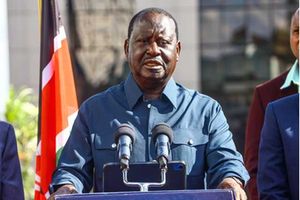When Kenyan military was a dwarf among several giants

Soldiers take part in a simulated military exercise of the British Army Training Unit in Kenya and the Kenya Defence Forces in Laikipia. A leaked document published in mid 1970s illustrated the military power of five eastern Africa countries. PHOTO | FILE | AFP
What you need to know:
- In terms of equipment, the country’s military had 3 Saladin and 10 Ferret armoured vehicles.
- Tanzania was second from bottom with 13,000 army, 600 navy, and 1,000 air force personnel.
- Uganda played in the big league with an army of 20,000; air force of 1,000, and a lake-patrol service that made Migingo a no-go zone for Kenyans.
A leaked document published in mid 1970s illustrated the military power of five eastern Africa countries.
Kenya was ranked at the bottom with 6,500 army personnel and 700 and 730 Air Force and navy personnel, respectively.
Para-military GSU had 1,800 men.
In terms of equipment, the country’s military had 3 Saladin and 10 Ferret armoured vehicles; 16, 81mm and 8, 120mm mortars; 56 84mm recoilless guns, and 4 patrol boats each with 4.4mm Bofors guns.
In the skies, the country had 14 combat aircraft; four Hunter FGA-9 ground attack fighters and five BAC-167 Strikemasters.
TANZANIA
Tanzania was second from bottom with 13,000 army, 600 navy, and 1,000 air force personnel.
In hardware, it had 20 Chinese T-59 medium and T-62 light tanks; 24 Soviet 76mm guns; 18 Chinese Howitzers, and 37mm anti-aircraft guns, and 12 MIG fighter jets. In the seas it had six Shanghai motor torpedo boats.
UGANDA
Uganda played in the big league with an army of 20,000; air force of 1,000, and a lake-patrol service that made Migingo a no-go zone for Kenyans.
Museveni’s country also had 50 medium and 20 amphibious tanks; 40 MIG jet fighters, and 160mm anti-aircraft guns.
Somalia was neck-to-neck with Uganda with 20,000 army; a navy of 3000; Air Force of 2,700, and guerilla squads of unknown numbers. For fighting hardware, it had 200 Russia supplied T-34 and T54 tanks; 310 armoured carriers; 100 anti-aircraft guns; 62 MIG jet-fighter jets and 14 motor torpedo boats.
Ethiopia was the big boy in the field with an army of 41,000 personnel; Air Force of 2,300; navy of 1,500; a paramilitary of 14,000 commandos, and a Recce squadron trained only in killing.
It had a fighting machine of 200 long-range tanks; 70 high-calibre Howitzer guns and 100 bomber jets.
PRUDENT CHOICE
In an interview, a minister in President Jomo Kenyatta's government Mr Geoffrey Kareithi told me the choice by Kenya not to invest in the military was deliberate, but with safety valves put in place.
He recalled the first Kenyan President asking in a Cabinet meeting: “Did we shed blood fighting colonialists only to arm ourselves to kill one another and to kill our brothers and sisters in neighbouring countries?”
Instead, Mr Kareithi told me, the priority decided by the Kenya government was to have food security, provide health, and education for the populace.
Thus, as it was, safeguards were put in place should the country be confronted by a crisis that needed military intervention.
At independence, the British government wanted to construct a giant military base at the place where today stands Kenyatta University.
The facility was to defend Kenya in case of outside aggression, and also secure western interests in the Horn of Africa and in the Middle-East.
However, the plan couldn’t work because the independent Kenya government wasn’t comfortable with that kind of agreement that could have sent wrong signals that Kenya was still a British colony.
On the sly, Americans also sabotaged the plan, because they weren’t comfortable that Britain was the one to put up such facility.
Uncle Sam wanted to do it himself by putting up that kind of facility in Djibouti and in the Indian Ocean island of Diego Garcia.
LANET MUTINY
However, the Kenya government struck a deal with the British that their troops retain a huge, but concealed military presence in Kenya.
The usefulness of the deal agreed was first tested when soldiers at the Nakuru-based Lanet Army barracks staged a mutiny.
British troops in Kenya moved first to quell the uprising. Soon after, the British military would play a key, but behind the scenes role, in bringing to an end the Shifta insurgency.
But Kenya didn’t just rely on the British to secure the territory.
Mr Kareithi told me of the military pact struck with Ethiopia, and which still stands, that a military attack on either country should be jointly confronted.
GROUND KAMPALA
As for Uganda, Mr Kareithi told me, the shield strategy was that Kenya ground the land-locked country should its militarily confront Kenya.
This was tested in 1976 after Kenya facilitated Israelis to rescue their hostages at Entebbe Airport.
To revenge, Uganda President Idi Amin ordered his troops to invade Kenya.
Mr Kareithi vividly remembers events of the day when Kenya got a clear signal that Ugandans were coming.
He was presiding over a church fund-raising meeting on a Sunday afternoon when his bodyguard gave him a piece of paper with message that then Intelligence head Mr James Kanyotu was on the hotline.
A police chopper was airborne to pick Mr Kareithi for an emergency national security committee meeting at State House, Nakuru.
Mr Kareithi told me that at the meeting, it was resolved that the same afternoon, Kenya Air Force jets make a sonic boom (military term for war cry made by fighter jets) at Kenya-Uganda border to tell the Uganda despot that Kenya was prepared for him.
But what really scared President Amin was realisation he didn't’ have enough fuel for his tanks to roll past the border with Kenya, and that spare parts for his tanks were at Mombasa port.
REAL SCARE
The big threat that made Kenya take steps to arm herself, Mr Kareithi told me came in 1978 when Somalia went on war with Ethiopia, after Somalis claimed ownership of Ethioipia’s Ogaden province. Somali fighter jets would overfly Kenya airspace and their tanks cruise through Mandera to raid Ethiopia.
“That forced us to change our defence strategy”, Mr Kareithi recalled.
A high-powered delegation led by Vice-President Daniel Moi and Defence PS Jeremiah Kiereini flew out to Washington, London and Bonn to negotiate secure to seal agreements for rapid upgrading of the Kenya military.
Mr Kareithi recalled President Kenyatta remarking to him after the Kenyan delegation made a report of their mission abroad to the Commander-in-Chief at State House, Nakuru.
The President had said in vernacular: “Ona mwendi thayu ni akoragwo na njora hiithe!” (Even the one who loves peace must have a hidden sword!”).
It wasn’t much different from what US President John F. Kennedy had said to justify his country’s resolve to be world’s most mighty military power.
He’d said: “We shall never fear to negotiate. But we shall never negotiate out of fear.”





